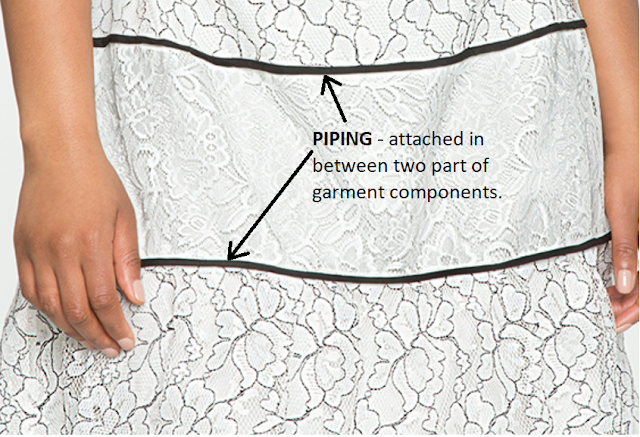Though the piping and binding terms are used interchangeably by many, binding and piping are not the same thing. There is some difference between a binding and a piping when we look at its construction and its application in a garment. In this post, the primary difference between these two terms is explained using examples.
Both the piping and binding are made of fabric stripes. The binding and piping stripe can be cut on a flat table in the same marker of cutting garment components. The other way of making binding and piping tapes - first making the fabric role and cutting the role to get the binding or piping role. The 3rd option of making binding role is using
an auto piping cutter, which cut the tape from a fabric and makes the piping role simultaneously.
 |
| An example of Piping |
Binding is used to clean finish edges of a garment part where piping is used mostly for decorative purpose. A good example of piping is t-shirt neck binding and sleeve placket binding in a shirt sleeve,
Example of binding: Inner vest armhole and neck finishing using binding. T-shirt neck binding. T-shirt neckline can be finished in different ways. So, all neck-line finishing is not a binding. Follow the below image for binding. The
seam construction of a binding can be done in various ways.
 |
| An example of Binding in T-shirt neck finishing |
 |
| An example of binding -Vest neck and armhole finishing |
A common use of piping is in pajama collar and lapel edge. In ladies dresses piping are found.
 |
| An example of piping |
Binding can be done in a single operation using a binder (an attachment) in a flatlock sewing machine. By using a lock stitch machine binding can be sewn in two-stage operations.
In piping, normally the stitches are hidden between the seam. In binding the stitching visible. The piping construction may vary according to the application area. the below example of piping in a Pyjama collar, the topstitch is visible.
In some designs, a cord is inserted inside the piping to make the piping shape tubular.
The purpose of piping is also making the seam strong and reduce seam slippage. In bags and cushion cover edges, piping is a common use.
For self-fabric binding, a bias-cut fabric is used for woven where a curve seam is used.
Seam Construction:
A common seam construction of piping and binding are shown in the below image. To be noted binding and the piping seam can be constructed in many ways. Refer to
A&F seam guide for more reading and understanding the seam construction of different ways of forming and stitching piping and binding seam.
 |
| Piping and binding seam construction in line diagram |





